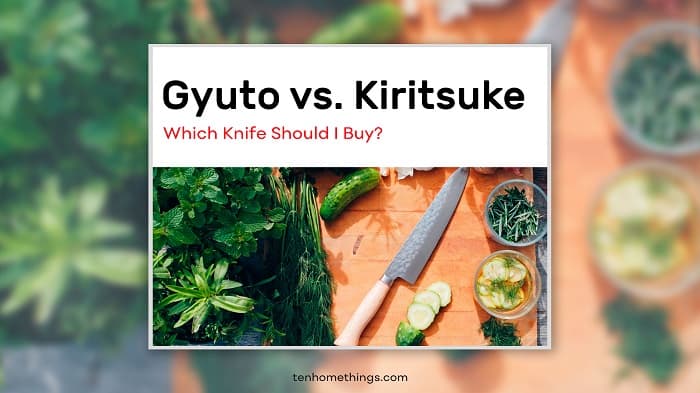
Have you ever heard of the legendary “Cow Sword” or Gyuto? How about the Kiritsuke, a fabled blade once only wielded by executive sushi chefs? Which is better? What’s even the difference between them? Which one should you get? This article will attempt to answer these questions and more.
Table Of Contents:
- What is the Difference Between a Gyuto and Kiritsuke?
- 3 Common Uses of Kiritsuke Knife
- 3 Common Uses of Gyuto Knife
- The Final Verdict
- What is a Gyuto knife good for?
- Are Gyuto knives better than Kiritsuke knives?
- Is Gyuto good for sushi?
- Can you cut meat with a Kiritsuke knife?
- What size of Kiritsuke knife is best?
What is the Difference Between a Gyuto and Kiritsuke?
The main difference between a Gyuto and a Kiritsuke is in their shapes. The Gyuto has a curved edge and a rounded spine. The Kiritsuke has a flat edge and a flat spine, with an angular shape that creates a really sharp and straight tip. Traditionally, Kiritsuke knives were always single-beveled and reserved for executive sushi chefs.
Gyuto knives, on the other hand, were designed after European all-purpose knives and excel in versatility. The name Gyuto also translates to “Cow Sword.” Today, Kiritsuke can also be double-beveled, which is much more usable for the average cook.
back to menu ↑
3 Common Uses of Kiritsuke Knife
1) Slicing (Especially Pull Cut)
The Kiritsuke is excellent at slicing but is much more competent at pull cuts than push cuts. This is because push-cutting with a Kiritsuke requires you to be much more careful. If you use a Gyuto often and try to push cut with a Kiritsuke the same way, your blade might be at too high of an angle. When slicing with a Kiritsuke, you must avoid rocking back and forth like you can with a Gyuto.
The tip will dig into the cutting board, which may break the tip-off. Instead, if push cutting, keep the knife almost parallel with the cutting surface and pick the knife up between cuts. Be careful when push cutting, or opt for pull cutting whenever possible.
2) Chopping
Since the edge of the Kiritsuke is so flat, it excels at chopping. When you bring the blade down, much more of it will meet the cutting board’s surface than a Gyuto would. This reduces the chances that pieces of food hang on by a thread. Also, the edge will allow you to rest the tip very lightly against the board and guillotine the knife down onto your food.
3) Tip Work
When chopping or pull cutting, sometimes you want to use the tip in particular. The Kiritsuke’s flat profile allows the tip to be sharpened much more than the tip of a Gyuto. This will help when you want to leave part of your food intact. For instance, when dicing an onion, you might leave the root end intact and push the tip down into the onion when making the first set of cuts.
back to menu ↑
3 Common Uses of Gyuto Knife
1) Slicing (Push Cut and Pull Cut)
The Gyuto is an incredible knife for slicing. You can use a Gyuto to push cut without worrying too much about the tip digging into your cutting surface and breaking off. It can also be used to pull cut, albeit with less power. This, however, comes with improved accuracy. Pull cutting is typically recommended for delicate and intricate tasks, whereas push cutting is more of an all-purpose cut.
2) Rocking
A nice feature of the Gyuto is that it can be used to rock back and forth on food and chop or slice them more quickly. The rounded profile allows you to keep the blade against the cutting surface throughout your range of motion, and this helps to increase your speed.
3) Everything Else
The Gyuto is really an all-purpose juggernaut, and there’s hardly a task fit for a knife that a good Gyuto can’t handle. While it doesn’t particularly excel at guillotine chopping or carving out potato eyes, it could just as well be used to do these things. It was designed with versatility as the focus, and it shows.
back to menu ↑
The Final Verdict
Overall, the Kiritsuke and the Gyuto can both cut many foods and ingredients. It’s possible to make an entire dinner with only one of them. However, they really shine when combined. You can prepare dinner masterfully using a Gyuto for slicing and dicing and a Kiritsuke for intricate cuts and chopping.
There is also such a thing as a Kiritsuke-tip or K-tip Gyuto. This is basically a Gyuto with an angular spine that gives it the pointier sword-like edge. It doesn’t add much functionality and is effectively a cooler Gyuto. However, both knives are fantastic and versatile kitchen tools that would serve you well if taken care of. One of the most important aspects of taking care of a knife is cleaning and drying it properly. If you’re unfamiliar with how to do that, check out our guide on when and how to clean and sanitize your knife.
Frequently Asked Questions
back to menu ↑What is a Gyuto knife good for?
A Gyuto knife is good for anything you would use a knife for. No, really. The Japanese designed them to emulate the European all-purpose chef knives, which are meant to be used for all sorts of cuts.
back to menu ↑
Are Gyuto knives better than Kiritsuke knives?
Gyuto knives are arguably more versatile than Kiritsuke knives. However, that doesn’t mean they’re better. Kiritsuke knives are more adept at making sushi, slicing meat, and chopping, while the Gyuto is better at push cutting and quickly slicing ingredients. They are both great and versatile chef knives, and neither is better than the other in general.
back to menu ↑
Is Gyuto good for sushi?
As the Gyuto can be used for practically anything, of course, you can make sushi with it. However, Kiritsuke is traditionally sushi chef knives and will do a better job at preparing sushi.
If you’re looking for a sushi knife and already have a great all-purpose chef knife, a Kiritsuke will be better. However, if you don’t have an all-purpose knife yet, a Gyuto will slice your fish just fine. However, if you’re looking for a high-quality knife set, Calphalon knife sets are great!
back to menu ↑
Can you cut meat with a Kiritsuke knife?
You can absolutely cut meat with a Kiritsuke. It will slice through meat with its ultra-sharp edge as easily as a Gyuto, if not better. The executive sushi chefs that traditionally wielded the Kiritsuke would cut all sorts of fish and meat with it.
back to menu ↑
What size of Kiritsuke knife is best?
While there is no single best size of the knife, you should get a bigger knife than you probably think you should. A 270-millimeter or 10-inch Kiritsuke will be the best for slicing fish and meat. This may sound like a huge knife, but over time you will become accustomed to it, and it will feel normal. At the very least, getting a 210-millimeter or 8-inch knife for all-purpose usage is recommended.
Shanny
Shanny not only has an exceptional understanding of the foodie mindset and how nutrition works, she has also achieved her Master’s Degree in Education. Outside of her academic achievements, she loves writing food blogs. It's so much more than a list of meals though! Shanny creates helpful cookware guides and delicious recipes that are easy to follow. She does all of this as a food blog writer because she loves it. That's why she spends lots of time testing out different recipes in her own home. She truly is a one-of-a-kind foodie, from her home to yours - with a story to tell, new recipes to indulge in and new tips to tantalize those tastebuds.












